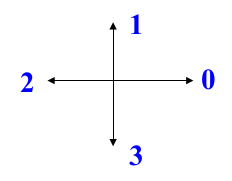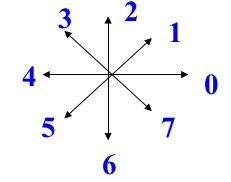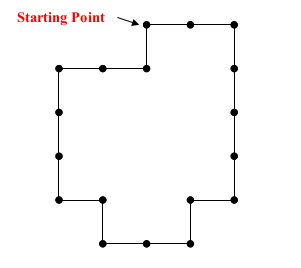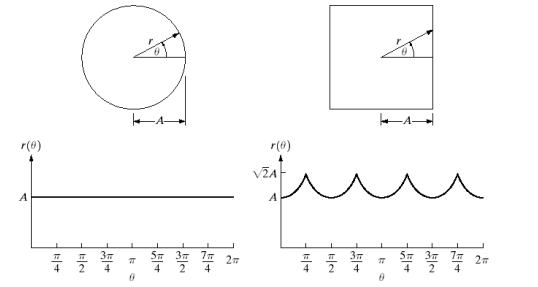1. Introduction
- Course: CoE4TN4 Image Processing
- Chapter: 11 - Image Representation & Description
- Institution: McMaster University
2. Image Representation & Description: Basics
- After segmentation, regions are represented and described in a form suitable for computer processing using descriptors.
- Representing a Region:
- External Characteristics: Focus on the boundary. Example: Length of the boundary.
- Internal Characteristics: Focus on properties like color and texture.
- Goal: Descriptors should ideally be insensitive to rotation and translation.
3. Chain Code
-
Definition: Represents a boundary by a connected sequence of straight-line segments.
-
Uses either 4 or 8 connectivity.
-
Method:
- Follow the boundary (e.g., clockwise).
- Assign a direction code to each segment connecting pixel pairs.
-
Direction Codes (Mermaid Diagram):


 Exp: 003333232212111001
Exp: 003333232212111001
-
Problems:
- Dependent on the starting point.
- Changes with rotation.
-
Solutions:
- Circular Sequence: Treat the chain code as circular; find the minimum magnitude representation.
- First Difference: Count counterclockwise the number of direction changes between adjacent elements.
- take difference between two consecutive direction number (the latter - the former), and if it is negative, add 4.
- Example, chain code:
- First difference code:
-
Shape Number: is the first difference of smallest magnitude.
4. Signature
-
Definition: A 1-D functional representation of a boundary.
-
Generation Methods:
- Plot distance from centroid to boundary as a function of angle.
-
Example Signatures:

-
Other methods can also be used, such as by plotting the angle between the tangent to the boundary at a specific location and a reference line.
-
Invariance:
- Translation: Signatures are inherently invariant to translation.
- Rotation: Choose a consistent starting point (e.g., farthest from centroid).
- Scaling: Normalize to a specific range.
-
Slope-Density Function: A histogram of tangent-angle values. Peaks correspond to straight segments.
6. Simple Boundary Descriptors
- Length: Number of pixels along the contour.
- Diameter: , where and are points on the boundary.
- Curvature: Rate of change of slope. (For digital images, difference between slopes of adjacent segments).
- Major Axis: Straight line segment joining the two farthest points on the boundary.
- Minor Axis: Perpendicular to the major axis, forming a bounding box.
- Eccentricity:
- Basic Rectangle (Bounding Box): Rectangle formed by major and minor axes.
.webp) chapter11 (1), p.16
chapter11 (1), p.16
7. Fourier Descriptor
-
Given an N-point boundary represented by coordinates: .
-
Represent the boundary coordinates as a complex sequence:
-
Calculate N point DFT of s(k):
- are the Fourier Descriptors.
-
By using P of the Fourier descriptors, we can find the following:
- If High frequency details of the boundary will be removed.
-
Properties:
- Not directly insensitive to translation, rotation, and scaling.
- Magnitude of Fourier descriptors is insensitive to rotation.
8. Regional Descriptors
- Area: Number of pixels within a region.
- Compactness:
- Min/Max Gray Levels: Minimum and maximum pixel values in the region.
- Mean and Median Gray Levels: Average and median pixel values.